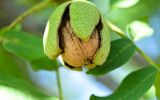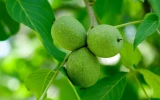3 Types of Walnut Trees in Ohio (With Pictures)
Ohio's diverse landscape is home to several species of walnut trees, each contributing unique characteristics and value to the region's flora. These walnut species not only enhance Ohio's natural beauty but also provide economic and ecological benefits, despite their allelopathic tendencies.
In Ohio, the walnut trees cultivated are the Black Walnut (Juglans nigra) known for its valuable hardwood and edible nuts, the Butternut or White Walnut (Juglans cinerea), recognized for its sweet nuts and woodworking-friendly lumber, though it's rarer due to disease, and the English Walnut (Juglans regia).
Here's a catch: while these trees add beauty and value, they also engage in a silent battle beneath the soil, secreting chemicals that deter the growth of competing plants, a phenomenon known as allelopathy. What are those chemicals, and what do they do to the trees?
Summary
- The Black Walnut tree is common in Ohio, especially in moist bottomlands.
- Butternut, is another native species to Ohio. It's less common than the Black Walnut and is known for its distinctive light-colored wood that's used in woodworking projects.
- Originally from Europe, the English Walnut is known for its delicious nuts and requires full sun and well-drained soil to flourish.
- These walnut trees produce the allelopathic compound juglone. When planting trees, this allelopathic characteristic should be taken into consideration.
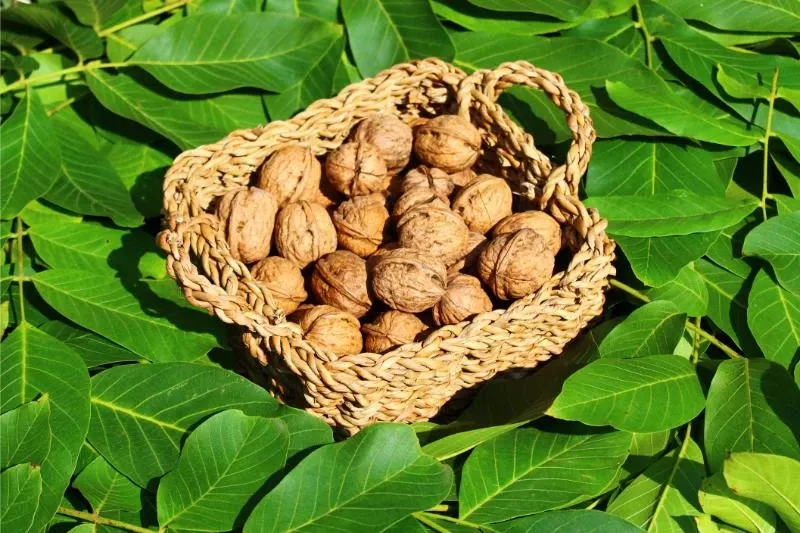
On this page:
| Species | Size (Height and Diameter) | Nut Characteristics | Habitat Preferences |
|---|---|---|---|
| Black Walnut (Juglans nigra) | 50-75 ft (occasionally up to 150 ft) x 2-4 ft | Thick green husk, hard-shelled nut, rich flavor | Rich, well-drained soils in mixed forests; less common in wet/poorly drained soils |
| Butternut (White Walnut, Juglans cinerea) | 40-60 ft tall, 1-2 ft in diameter | Green husk, high oil content, sweeter nut | Well-drained, rich soils; found along streams, rivers, and in woodlands; less tolerant of dry or infertile soils |
| English Walnut (Juglans regia) | 40-60 ft tall, 2-3 ft in diameter | Thinner shell, mild flavor, smooth green husk | Deep, fertile, well-drained soils; full sun; primarily in cultivated landscapes; less cold-hardy |
Black Walnut (Juglans Nigra)
The Black walnut, known scientifically as Juglans nigra, is a cherished species among nut trees in Ohio. Its leaves are pinnately compound, typically with 15–23 leaflets, while the fruit appears as large, rounded, inedible drupes that house the edible nuts.
When considering this hardwood for your landscape, keep in mind it thrives in full sun and well-drained soil but is known for its chemical impact on surrounding plant life due to being allelopathic. Your Black walnut will provide generous shade to your yard with its expansive foliage.
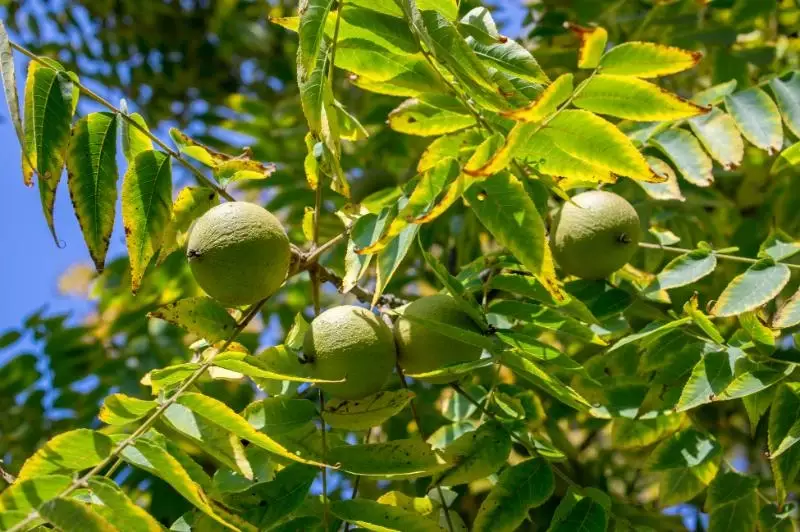
As for appearance, the tree's bark is thick, dark, and furrowed with deep ridges. Come autumn, the foliage turns a bright yellow, offering a striking contrast. Wildlife, especially squirrels, favor Black walnuts for their sweet nut flavor.
In the realm of woodworking and furniture making, the timber of Black walnut is unparalleled. It's often used for gunstocks due to its strength and beautiful grain. However, beware of canker disease, which can affect the health of your tree.
Black walnut is part of a larger family, Juglandaceae, and lives harmoniously along streams and rivers. Its blooms are catkin-type clusters that add a subtle charm in the spring. If furniture making or woodworking piques your interest, black walnut's wood is a top choice for its quality and workability.
To grow black walnut trees for profit, you may read this comprehensive guide.
Butternut Or White Walnut (Juglans Cinerea)
The Butternut, or White Walnut (Juglans cinerea), is an appealing hardwood species native to Ohio. Recognized for its distinctive light gray bark, this tree serves as an important part of the local landscape and supports regional wildlife.
The high-quality nuts produced by the Butternut are enjoyed by various creatures, particularly squirrels.
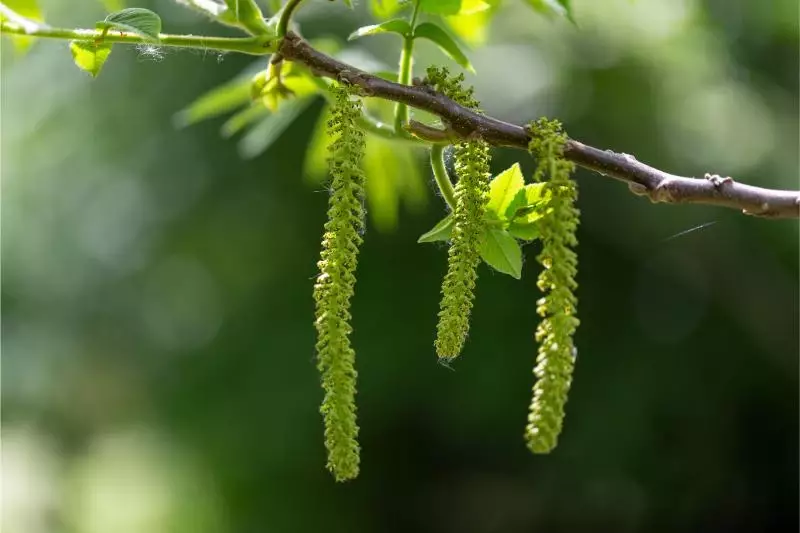
Butternut trees have compound leaves, with typically 11–17 leaflets offering a lush, vibrant display before they shed in the fall. The tree adds to the aesthetics of any space, casting a gentle shade with its broad crown. In spring, it produces flowers, contributing to the area's natural beauty.
The Butternut's light-weight, beige-pink wood is sought-after for its applications in woodworking and furniture due to its ease of workability. Although less durable than some other hardwoods, it carves well and thus is appreciated for various artisanal projects.
Your Butternut trees will require well-drained soil, with a preferred soil pH that's slightly acidic or neutral.
English Walnut (Juglans Regia)
The English Walnut, scientifically known as Juglans regia, is a valued species originally from Europe. This walnut variety prefers a landscape with full sun, which encourages a healthy and robust canopy.
Your English Walnut tree will thrive when planted in well-drained soil and clear, open areas. It prefers a Mediterranean climate with mild, wet winters and hot, dry summers. It's less cold-hardy than other nut trees and can be damaged by late spring frosts.
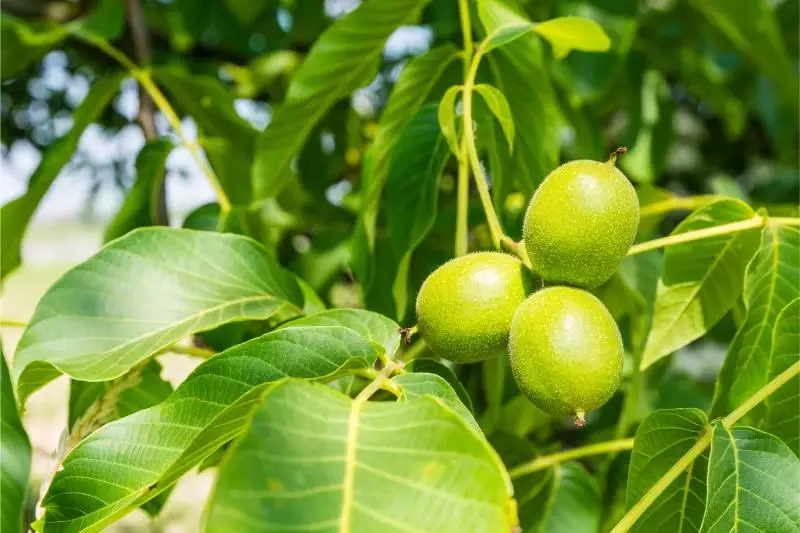
The foliage of the Juglans regia is typically lush. The tree's twigs and leaves deliver a fetching aesthetic to any garden with their vibrant green color. In spring, your tree's bloom will feature both male flowers, called catkins, and smaller female flowers, which yield the tree's fruit – the walnut nuts.
The English Walnut's fruit is cherished for its delicious nuts encased in a smooth, green husk. Unlike the pecan and hickory, the fruit of the English Walnut tree is larger and has a more robust flavor.
As your English Walnut tree matures, it develops a dark brown bark, which is both attractive and sturdy, making it a sought-after wood for furniture production.
In Ohio, when you're considering the addition of walnut trees to your property, keep in mind the nurturing needs of the English Walnut compared to other regional species like the pecan, hickory, or even the Native American chestnut and beechnut.
This walnut variant isn't just a source of nutritious nuts, but also a splendid addition to your landscape, joining the diverse family of oak, birch, and various walnut types such as the California black walnut and Japanese walnut.
Growing and caring for walnut trees
When you decide to grow walnut trees in Ohio, understanding the specific needs and challenges they face is crucial. Your success in nurturing these trees lies in appreciating their soil and sunlight needs, addressing common growing challenges, and recognizing their value to wildlife and the ecosystem.
Soil and sunlight requirements
Walnut trees flourish in well-drained soils, especially in the rich bottomlands near rivers and streams. They require full sun, meaning at least six to eight hours of direct sunlight daily, to ensure optimal growth and nut production.
Avoid areas with shallow, rocky soil or that receive only partial sun.
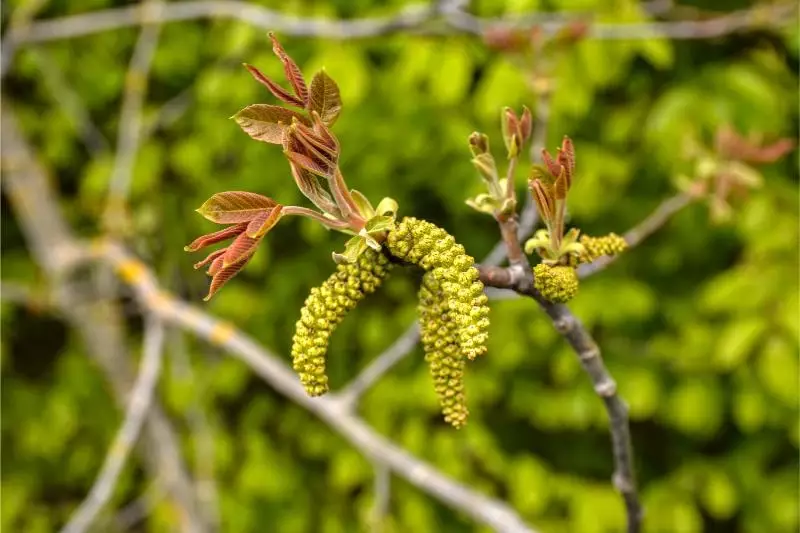
Some specific regions in Ohio where you can find moist bottomlands include:
- Along the Ohio River and its tributaries, which stretch across the southern border of the state.
- In the vicinity of the Scioto River, which flows through central Ohio including the Columbus area.
- Near the Great Miami River and the Maumee River, which are significant waterways in western Ohio.
- Along the Cuyahoga River in northeastern Ohio, which flows through the Cuyahoga Valley National Park.
- By the Muskingum River, which runs through eastern Ohio.
Common challenges and solutions
You may encounter challenges like walnut blight, canker diseases, and pests such as the walnut husk fly. Watch for signs of these problems and combat them using recommended treatments like fungicides or insect traps.
One particular substance walnut trees produce is juglone, which is toxic to certain plants. Juglone is a natural compound found in all parts of the walnut tree, including the leaves, bark, nut hulls, and roots. It's a chemical that is toxic to many other plants, which can inhibit the growth of certain species under their canopies.
Ornamental and timber uses
Walnut trees serve dual roles as both ornamental and timber trees. The wood is highly valued for making furniture, gunstocks, and even intricate veneer, while the tree itself adds stately beauty to landscapes.
Wildlife and ecosystem contributions
Your walnut trees will serve as a vital part of the local ecosystem, offering sustenance and shelter to wildlife such as squirrels. The nuts provide rich, edible kernels, while the husk and shells can be used in various applications, including cleaning and dyeing.
Harvesting and utilization of walnuts
Once mature, walnuts can be harvested and utilized in many ways, from eating the edible oily kernels to using the hard shells in commercial products.
Walnut timber is also sought after for making high-quality furniture and gunstocks, reminiscent of the same wood once used for American chestnut tool handles.
Cultural and historical significance
The walnut tree holds significant historical value. In Ohio, like the rest of America, walnut trees have been used to create not only functional objects like tool handles and timber but also as a cultural symbol of strength and longevity.


